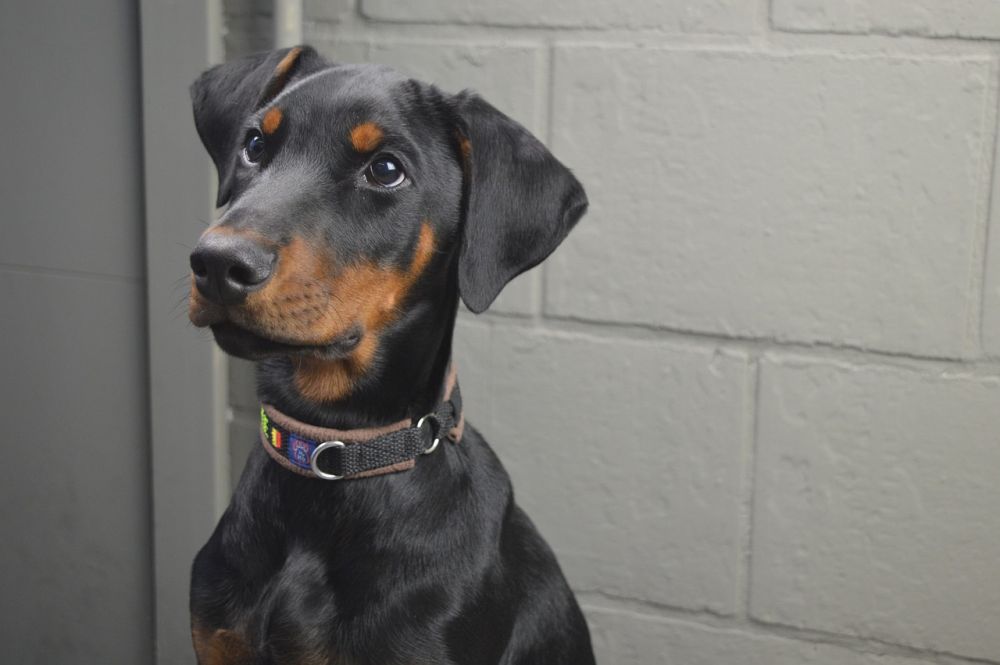
Dog Breed Guide: Doberman Pinscher
Anyone who remembers eighties TV remembers Higgins’ iconic Dobermans, Zeus, and Apollo. They were the pampered protectors of Higgins, and they were prime specimens of this poised and dignified breed.
Their sudden appearance was the punchline in many a screen joke, and many people (myself included) were very glad not to be involved in those confrontations! But while Dobies (as they are known by many who love the breed) are definitely good guard dogs, they’re also a popular breed throughout the world.
History of the Doberman Pinscher
As you might have guessed from the name, the Doberman was first bred in Germany. What you might not know is that, unlike many breeds that have a murky history with many contributors, Dobermans were the creation of one man, Louis Doberman.
Mr. Doberman was a tax collector in Thüringen in the late 1800s. People didn’t appreciate tax collectors too much, and robbing these officials was common, so he decided to breed a large, easily trained, and intimidating dog. The Doberman was the result. Well done, Louis!
By 1908, the dog we know today had made its way to America (and into many police forces) as guard dogs and later as family pets. They’ve served in wars, starred in TV shows, and are frequent fixtures on the list of most popular breeds.
General Physical Characteristics of Doberman Pinschers
Dobermans are large dogs, between 24 and 28 inches tall, and tipping the scales at between 65 and 90 lbs. They’re sleek and well-muscled and seem to be built for speed and efficiency.
They have relatively small heads and long, pointed, slightly square-jawed faces, and they always have the same markings, whether it’s in the well-known black and tan color, red, blue, or chocolate. Rarely, you will encounter a pure white Doberman, but these are albinos, and it is a genetic defect, not a recognized breed color.
A very short coat and typically docked tail means there’s almost no grooming to be done on this breed, and while there are some people who crop their ears, they should be left alone, to flop as they were made to.
One thing that will surprise you about this dog is the size of their feet, which are small, neat, and almost catlike and sometimes look a little out of place on such a large dog.
Temperament and Character of Doberman Pinschers
Dobermans are good with dogs and cats that they know and have grown up with and not bad with older kids. They are very easy to train and are intelligent and loyal dogs.
They do, however, live up to the media stereotypes on most occasions, and they are naturally great watchdogs who are not generally friendly with strangers or other dogs that they don’t know.
Dobies are also strong-willed dogs that need an equally strong-willed owner who is willing to put the time and effort into training them. They are very smart and will thrive with the mental stimulation that comes from advanced training and even competing in obedience and other types of competition.
Lifespan of the Doberman Pinscher
Dobermans usually live between 10 and 12 years.
Common Health and Personality Issues in Doberman Pinschers
Dobermans tend to be more prone to serious diseases and disorders than many other large breeds. Those conditions include:
- Cervical spondylomyelopathy, or wobbler’s syndrome, is a disorder of the cervical spine that causes a variety of symptoms, particularly the wobbling gait that it’s named for.
- Cardiomyopathy, or an enlarged heart, is caused by various defects.
- Von Willebrand’s Disease is a blood disorder.
- Demodicosis is a particular type of mange that is more common in Dobermans than many other breeds.
- Gastric torsion or bloat.
- Hip dysplasia, as with many other large breed dogs.
- Osteosarcoma, or malignant bone cancer.
- Hypothyroidism, or underactive thyroid.
- Albinism, although this is of course apparent from birth, and won’t affect the overall health of the dog, except to make them very prone to sunburn and even skin cancer.
- Narcolepsy, where the dog suddenly falls asleep for long periods of time.
Dobermans are great companions, and they definitely combine power and grace into one very impressive package.
If you are looking for a dog that will be a great part of your pack, and be your protector, and if you are prepared to be a hands-on owner who doesn’t skimp on training, exercise, and mental stimulation in the form of training and even competition, then the Dobie may well be the breed for you.
